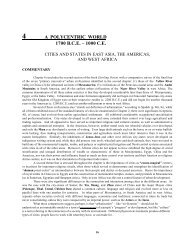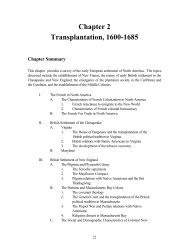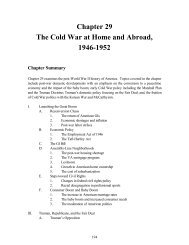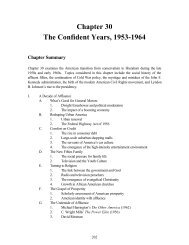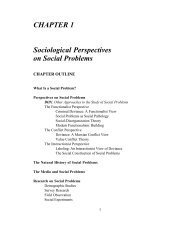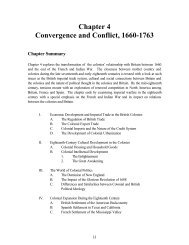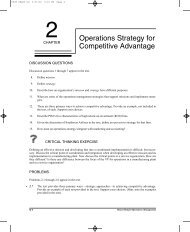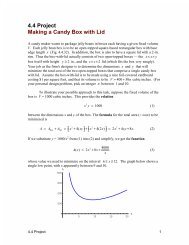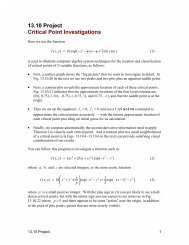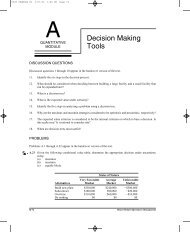Merchandising Operations and the Accounting Cycle - Pearson
Merchandising Operations and the Accounting Cycle - Pearson
Merchandising Operations and the Accounting Cycle - Pearson
You also want an ePaper? Increase the reach of your titles
YUMPU automatically turns print PDFs into web optimized ePapers that Google loves.
WORKING IT OUT<br />
Best Company Ltd. sold $2,000 of<br />
merch<strong>and</strong>ise to Super Sales Co.<br />
on March 1, 2003, <strong>and</strong> granted a<br />
5% quantity discount off that list<br />
price. Super Sales returned<br />
merch<strong>and</strong>ise on March 4, <strong>and</strong> Best<br />
granted Super Sales a sales<br />
allowance of $200. Best Company<br />
Ltd. collected <strong>the</strong> balance on<br />
March 9, after subtracting a 2%<br />
sales discount. Record Best’s<br />
collection of cash on March 9.<br />
A:<br />
Cash 1,666 1<br />
Sales Discounts 34 2<br />
Accounts Receivable 1,700 3<br />
1 $2,000 0.05($2,000) $1,900<br />
$1,900 $200 = $1,700<br />
$1,700 0.02($1,700) $1,666<br />
2 $1,700 0.02 = $34<br />
3 $2,000 0.05 ($2000)200$1,700<br />
234 Part One The Basic Structure of <strong>Accounting</strong><br />
Suppose JVC grants to <strong>the</strong> buyer a $100 sales allowance for damaged goods.<br />
Austin Sound <strong>the</strong>n subtracts $100 from <strong>the</strong> amount it will pay JVC. JVC journalizes<br />
this transaction by debiting Sales Returns <strong>and</strong> Allowances <strong>and</strong> crediting<br />
Accounts Receivable as follows:<br />
July 15 Sales Returns <strong>and</strong> Allowances.................................. 100<br />
Accounts Receivable............................................. 100<br />
Granted a sales allowance for damaged goods.<br />
No inventory entry is needed for a sales allowance transaction because <strong>the</strong> seller, JVC,<br />
receives no returned goods from <strong>the</strong> customer. Instead, JVC will simply receive less<br />
cash from <strong>the</strong> customer.<br />
After <strong>the</strong> preceding entries are posted, all <strong>the</strong> accounts have up-to-date balances.<br />
JVC’s Accounts Receivable has a $6,500 debit balance, as follows:<br />
Accounts Receivable<br />
(Sale) July 7 7,200 July 12 600 (Return)<br />
July 15 100 (Allowance)<br />
Bal. 6,500<br />
On July 22, <strong>the</strong> last day of <strong>the</strong> discount period, JVC collects $4,000 of this accounts<br />
receivable. Assume JVC allows customers to take discounts on all amounts<br />
JVC receives within <strong>the</strong> discount period. JVC’s cash receipt is $3,880 [calculated as<br />
$4,000 – (0.03 × $4,000)], <strong>and</strong> <strong>the</strong> collection entry is<br />
July 22 Cash.............................................................................. 3,880<br />
Sales Discounts. .......................................................... 120<br />
Accounts Receivable............................................. 4,000<br />
Cash collection within <strong>the</strong> discount period.<br />
Sales discount is $120 (0.03 $4,000).<br />
Suppose JVC collects <strong>the</strong> remainder of $2,500 on July 28. That date is after <strong>the</strong> discount<br />
period, so <strong>the</strong>re is no sales discount. To record this collection on account, JVC<br />
debits Cash <strong>and</strong> credits Accounts Receivable for <strong>the</strong> same amount, as follows:<br />
July 28 Cash.............................................................................. 2,500<br />
Accounts Receivable............................................. 2,500<br />
Cash collection after <strong>the</strong> discount period.<br />
In Exhibit 5-1, The Forzani Group Ltd.—like most o<strong>the</strong>r businesses—reports to <strong>the</strong><br />
public only <strong>the</strong> net sales figure. But FGL managers use <strong>the</strong> return <strong>and</strong> allowance<br />
data to track customer satisfaction <strong>and</strong> product quality.<br />
Goods <strong>and</strong> Services Tax<br />
This topic is introduced here to make you aware of <strong>the</strong> goods <strong>and</strong> services tax because<br />
most goods <strong>and</strong> services sold today in Canada have <strong>the</strong> Goods <strong>and</strong> Services Tax (GST)<br />
levied on <strong>the</strong>m by <strong>the</strong> federal government at <strong>the</strong> time of sale. However, it was decided<br />
to omit consideration of <strong>the</strong> GST from <strong>the</strong> discussion <strong>and</strong> examples in <strong>the</strong> early<br />
chapters to avoid making <strong>the</strong> material overly complicated. The following discussion<br />
provides a brief introduction to <strong>the</strong> topic; GST is dealt with more fully in Chapter 11.<br />
The manufacturer, wholesaler, <strong>and</strong> retailer pay <strong>the</strong> GST on <strong>the</strong> cost of <strong>the</strong>ir purchases,<br />
<strong>and</strong> <strong>the</strong>n pass it on to <strong>the</strong> next link in <strong>the</strong> economic chain by charging <strong>and</strong><br />
collecting it on <strong>the</strong>ir respective sales. The consumer, <strong>the</strong> last link in <strong>the</strong> chain, pays<br />
<strong>the</strong> final tax. Each entity that collects <strong>the</strong> GST remits <strong>the</strong> tax collected to <strong>the</strong> Receiver<br />
General at <strong>the</strong> Canada Customs <strong>and</strong> Revenue Agency (CCRA).<br />
The GST is designed to be a consumption tax <strong>and</strong>, as was suggested above, <strong>the</strong><br />
entity ultimately paying <strong>the</strong> tax is <strong>the</strong> final purchaser of <strong>the</strong> product or service.<br />
Earlier links in <strong>the</strong> chain (for example, <strong>the</strong> retailer) pay tax on <strong>the</strong>ir purchases, but<br />
are <strong>the</strong>n allowed to deduct that tax from <strong>the</strong> tax <strong>the</strong>y <strong>the</strong>mselves collect on <strong>the</strong>ir



